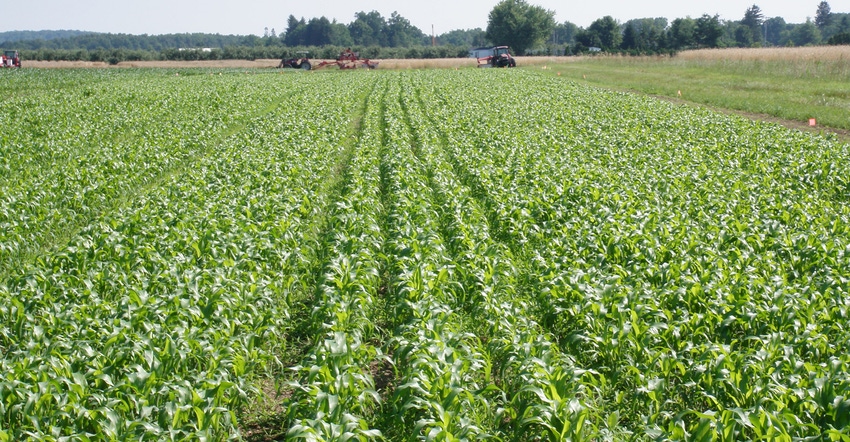June 9, 2021

As farmers search for the holy grail of milk production — higher-quality forage at lower cost — more are trying BMR and non-BMR forage sorghum or sorghum-sudan.
With some corn varieties topping $350 a bag — $140 an acre — BMR sorghum at 10 pounds of seed per acre costs only $20 an acre, and that’s before the crop is even planted. Nitrogen is similar to a good corn crop, and with seed treated by a safener, the proper herbicide can control weeds.
Research trials in the northern U.S. have shown mean yields of 35% dry matter silage that exceeded both the mean and the max yield of a corn variety planted next to it. Sorghum is easy to grow if you follow top yield practices.
As you move farther south into Ohio, Pennsylvania, Virginia and Kentucky, the potential for the crop increases even more. Sorghum thrives in these areas because it’s frequently hot, dry or both. Corn silage stops growing at temperatures over 85 degrees F. Sorghum continues to grow up to 105 degrees.
Conversely, in cool or cold summers, sorghum won’t do as well, and corn will clearly outyield it. The forecast for this summer is slightly warmer-than-usual temperatures. Here are five tips to consider:
1. Warmed-up soil is critical. Plant sorghum in soils that are at least 65 degrees. This is no problem in areas of Pennsylvania and Ohio, but soils in northern climates will likely be a little cooler.
If you rush and plant in cool soils — less than 65 degrees — and delay herbicide, weeds may overrun the field. We know this from past experience. On June 3, 2016, we started two days of planting a complex management trial.
Three days later when the seeds were absorbing water and swelling, we were hit by 40-degree weather and rain. The soil temperature at the 3-inch depth dropped to the low 50s. The entire stand was wiped out by seed chilling injury.
2. Drill in narrow rows. Planted at a 1-inch depth, we strongly suggest drilling in narrow rows, or planting in 15-inch rows or less if you have a chopper with a row-less head.
If you do not have access to that equipment, we suggest you use BMR sudangrass or BMR sorghum-sudan and use a multicut system with round bale wrapping.
A single-cut system will yield twice as much and at a quarter of the cost per ton as a multicut system. The narrow rows maximize sunlight interception in two to three weeks.
Sorghum species will tiller to fill in thin spots capturing all the sunlight. The result is a solid layer of leaves completely covering the ground. Our replicated trials showed 18% more yield in a 6-inch drilled row than a 30-inch traditional planting.
For forage sorghum, we suggest 10 pounds of seed per acre drilled; 8 pounds of seed per acre for 15-inch rows; and 5 pounds of seed per acre for 30-inch rows. A higher seeding rate in wide rows significantly increased lodging.
3. Start weed control right away. We buy seed with a safener and use atrazine, plus metolachlor or another registered grass control herbicide. The absolute key is to spray as soon as you get done planting. Delaying your spraying will allow the annual grass to get started in the warm soil, and the herbicide may not work.
For organic farms, we do not suggest sorghum, especially the brachytic dwarf that comes up very slow. It is a prescription for a weed disaster. We have tested the smaller-seeded, higher-population sorghum-sudan drilled into a warm, stale seedbed. We increased seeding rate to about 60 pounds per acre and had maximum yields with no weeds. Yields equaled or even exceeded that of sorghum.
The warm soil allows rapid emergence, and the crop essentially doubles in size each week. We have measured growth of 3 inches per day. Given a chance, it will outrun the weeds.
4. Watch for bugs and beasts. Corn rootworm is a not a problem as the worms die when they feed on sorghum. Adult rootworm does not lay eggs in it, so corn planted afterward will not be threatened.
Armyworms could be a problem. They can devour an entire field if they’re not controlled.
Deer hide in sorghum and come out to eat the neighbor’s corn. Male sterile sorghum at 18% sugar on a dry matter basis would probably be a candy store for the local bear population.
5. Consider nitrogen and sulfur. Nitrogen is a wild card. Sorghum is very efficient at picking up and retaining nitrogen because of its very fine and potentially deep root system.
We get a yield curve on our nitrogen trials, but looking back at the data, we got an increase in crude protein when we continued to add nitrogen past the point of yield increases. This is exactly what we learned in fertilizing winter forage.
The nitrogen level for yield and the nitrogen, plus sulfur for protein is very different. Farmers and nutritionists get jumpy at this point because of legitimate concerns over nitrate toxicity. Research has shown that a big part of that issue is not the nitrogen, but the shortage of sulfur.
We will be working on this question, but until we can nail it down, you should fertilize it like corn silage with the addition of sulfur.
Kilcer is a certified crop adviser in Kinderhook, N.Y.
About the Author(s)
You May Also Like




